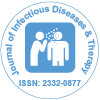当社グループは 3,000 以上の世界的なカンファレンスシリーズ 米国、ヨーロッパ、世界中で毎年イベントが開催されます。 1,000 のより科学的な学会からの支援を受けたアジア および 700 以上の オープン アクセスを発行ジャーナルには 50,000 人以上の著名人が掲載されており、科学者が編集委員として名高い
。オープンアクセスジャーナルはより多くの読者と引用を獲得
700 ジャーナル と 15,000,000 人の読者 各ジャーナルは 25,000 人以上の読者を獲得
インデックス付き
- 索引コペルニクス
- Google スカラー
- Jゲートを開く
- レフシーク
- ハムダード大学
- エブスコ アリゾナ州
- OCLC-WorldCat
- パブロン
- ユーロパブ
- ICMJE
役立つリンク
オープンアクセスジャーナル
このページをシェアする
抽象的な
Therapeutic Strategies for Post-Osteosynthesis Osteomyelitis
Dell'Aquila AM, Finelli CA, Fernandes HJA, Reis FB, Marra AR, Pereira CAP and Morais JF
Objectives: The main objective in post-osteosynthesis surgical site infection (SSI) is to consolidate the fracture and prevent chronic osteomyelitis. The purpose of this study is to evaluate the risk factors for SSI recurrence in patients treated for osteo-articular infection at the Federal University of São Paulo.
Methods: After retrospectively evaluating all SSI episodes occurring from December 2004 to December 2008 in patients undergoing osteosynthesis at the orthopedics department, 110 of them were included. SSIs were treated with at least 4-6 week antibiotic therapy cycles and followed up for one year with the results being analyzed using univariate and multivariate analysis models.
Results: Most patients were 18-89 years old, with a mean age of 39.8, the majority being male (84.5%). In 37 patients, the causative agent was isolated with Staphylococcus being the most frequently observed (38.8%). In 83 (75.4%) patients, the antimicrobial treatment mostly with ciprofloxacin and clindamycin was started within less than five days from the onset of symptoms. SSI recurrence occurred in 34/110 (30.9%) patients. After one-year follow-up, 19 (17.3%) patients persisted with infection and only 10 (9.1%) did not have their fractures consolidated. The univariate analysis showed the performance of more than one surgery to stabilize the affected limb (OR 3.7 IC95=1.1-12.7 p=0.045), presence of converting osteosynthesis (OR 3.6 IC95=1.1-11.3 p=0.023), internal synthesis (OR 3.0 IC95=0.99-9.2 p=0.043) and longer duration of surgery (OR 0.4 IC95=0.1-1.6 p=0.029) as risk factors for SSI recurrence. In the multivariate analysis, the only variable independently associated with SSI relapse was duration of surgery (OR 1.3 IC95=1.1-1.7 p=0.015).
Conclusions: After one year follow-up, using a specific protocol, most patients showed resolution of infection and only 9.1% had their fractures unconsolidated. The only independent risk factor associated with SSI recurrence was prolonged surgery. It is possible to treat a patient with post-osteosynthesis SSI with a course of 4 to 6 weeks of antibiotic therapy.

 English
English  Spanish
Spanish  Chinese
Chinese  Russian
Russian  German
German  French
French  Portuguese
Portuguese  Hindi
Hindi